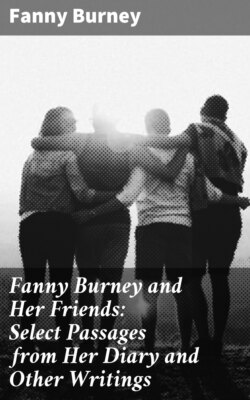Читать книгу Fanny Burney and Her Friends: Select Passages from Her Diary and Other Writings - Burney Fanny - Страница 4
На сайте Литреса книга снята с продажи.
Оглавление1. Owen and Blakeway’s ‘History of Shrewsbury,’ vol. ii., p. 388.
2. Actress and singer; married Theophilus Cibber, son of Colley Cibber. She was a special favorite with Handel, who wrote much of his contralto music for her. In the latter part of her career she was associated with Garrick at Drury Lane. Born, 1714; died, 1766.
3. This lady wrote verses, and acquired some repute by a poem entitled ‘A Prayer for Indifference.’
4. ‘Memoirs of Dr. Burney, by his Daughter, Madame d’Arblay,’ 1832.
5. Author of a didactic poem, ‘The Art of Preserving Health.’
6. Born at Lynn, December 4, 1756; LL.D. Aberdeen, 1792; vicar of Deptford, prebendary of Lincoln, chaplain to the King; died 1817.
7. The writer seems to have had in view the lines of Pope:
‘That live-long wig, which Gorgon’s self might own,
Eternal buckle takes in Parian stone.’
By the buckle of a wig was meant its stiff curl when in trim condition.
8. Walpole to Bentley, March 6, 1754.
9. Thorne’s ‘Environs of London.’ The name is now written Chessington, but we retain the spelling which was always used by Fanny Burney and her friends.
10. ‘Memoirs of Dr. Burney,’ vol. ii., p. 185.
11. Preface to the ‘Wanderer.’
12. Edward, brother of King George III.
13. The title-page runs: ‘An Essay towards the history of the principal Comets that have appeared since 1742; with remarks and reflections upon the present Comet; to which is prefixed a Letter,’ etc. London, 1769. It is a curious instance of Madame d’Arblay’s inaccuracy in the matter of dates, that she writes in detail of this little tract, the title of which she misquotes, as having been produced when ‘the comet of the immortal Halley’ was being awaited. (‘Memoirs of Dr. Burney,’ vol. i., pp. 214–217.) But it was in 1759, not 1769, that Halley’s Comet returned. For notices of the comet of 1769, see the Gentleman’s Magazine of that year.
14. The house is now No. 35. It was occupied by Newton from the time when he became President of the Royal Society down to his death in 1727. He did not actually die there, as has been sometimes stated, but at Orbell’s Buildings, Kensington, whither he used to resort for change of air. See Notes and Queries, Third Series, i. 29. For the number of the house during Dr. Burney’s occupation, see a letter from him to Fanny in her Diary, New Edition, vol. i., 297.
